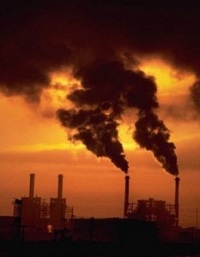Ian took this photo of the camp site about 8.25am. It shows how dry the place was and how insignificant we were in the vast desert expanse. Continue reading Simpson Desert crossing 5: Day 4
Monthly Archives: November 2014
Saturday salon 15/11

An open thread where, at your leisure, you can discuss anything you like, well, within reason and the Comments Policy. Include here news and views, plus any notable personal experiences from the week and the weekend.
For climate topics please use the most recent Climate clippings.
The gentleman in the image is Voltaire, who for a time graced the court of Frederick II of Prussia, known as Frederick the Great. King Fred loved to talk about the universe and everything at the end of a day’s work. He also used the salons of Berlin to get feedback in the development of public policy.
Fred would only talk in French; he regarded German as barbaric. Here we’ll use English.
The thread will be a stoush-free zone. The Comments Policy says:
The aim [of this site] is to provide a venue for people to contribute and to engage in a civil and respectful manner.
Here are a few bits and pieces that came to my attention last week.
1. Abbott puts his foot in his mouth
Yesterday David Cameron made a speech in Parliament about freedom and democracy. At an international business breakfast attended by David Cameron Abbott said there was ‘nothing but bush’ in Australia before white settlement.
The self-appointed “Prime Minister for Aboriginal Affairs” Tony Abbott has reiterated the legal fiction of “terra nullius” stating that Australia was “nothing but bush” before British invasion and called pre-colonisation civilisation “extraordinarily basic and raw”.
Will someone please take this embarrassing man away and give us a real prime minister?
2. Palmer DisUnited Party
Clive Palmer and Jacqui Lambie have been engaging in a colourful slanging match. Lambie says she won’t resign unless she’s kicked out, but she might have to distance herself from the party. Palmer says she won’t answer the phone or return his calls and that she raises no issues when the party meets. It’s hard to see this fracture being patched up.
According to a vox pop conducted in Tasmania, she has a bit of support, but many are scathing and find her embarrassing. Her attitude may make things harder for the LNP to get legislation through the senate, but will reduce Palmer’s leverage.
3. Rundle on Palmer
Meanwhile Guy Rundle has been studying the mercurial Clive Palmer’s politics. He finds the politics of Clive Palmer:
a mildly centre-right politics, grounded in Australian Catholic traditions and social movement doctrine, and tracing their lineage back to the party whose name he wanted to adopt, the United Australia Party.
Rundle identifies a doctrine on which the Australian political and social settlement is based.
Because the arbitration system and the Harvester judgement that inaugurated it took their moral language from Rerum Novarum, the 1891 encyclical that sparked off the Catholic social movements, we can say that it is this doctrine, and its secular variants, that sits at the very centre of Australian political values, and major parties depart too far from it at their peril. It consists not merely of a set of social rules, but of an idea of what it is to be human, an idea of depth, and of selfhood as achieved in the exercise of mutual obligation.
Such a doctrine, drawing also from nineteenth-century social liberalism and classical and Christian notions of freedom as flourishing within communal life, is a world away from the atomised and content-less self of classical liberal doctrine, and the neoliberal political-economic movement that derives from it.
He locates Palmer’s politics within this tradition. Abbott promised to govern within this tradition, but he lied.
Former Queensland premier Wayne Goss died during the week. Goss is noted for bringing the ALP back to power after 32 years of conservative rule and implementing the reforms recommended by Tony Fitzgerald in his inquiry into police corruption which flourished under Joh Bjelke Petersen. Fitzgerald described Goss as a man of “uncompromising integrity”.
The other Fitzgerald, Professor Ross Fitzgerald, described Goss as a “steady hand, but he really wasn’t a radical reformer”.
There was nothing steady about the way Goss’s government turned the public service inside out. In fact I left in 1991 in large measure because of the hypocrisy the Education Department displayed in ‘valuing people’. Ironically schooling in Queensland was modernised and humanised in the 1970s and 1980s under Joh, possibly because Joh himself took little direct interest in it and always handed education to a junior minister.
It’s astonishing to think that the magnificent Cultural Centre complex was built during the Joh years.
Still, the joint certainly needed cleaning up and Goss certainly did it.
5. Remembering the Berlin wall
“Die Mauer muss weg!” (“Away with the wall!”)
We also had the 25th anniversary of the destruction of the Berlin Wall during the week.
Originally it was assumed that the West would take over the East. Der Spiegel suggests that in fact there has been movement the other way and what has happened is that a genuinely new Germany has emerged.
6. WA plans to close Aboriginal communities
I couldn’t believe this when I heard it. The West Australian Government will close as many as 150 remote Aboriginal communities in the next three years.
The threat of US style managed health care
I’ve been cracking my brain over one of Getup’s latest campaigns – keeping medical insurers out of the direct provision of primary health care.
The issue has come to a head with the federal government’s review of the $1.8 billion Medicare Local scheme. In brief, the 61 existing Medicare Locals are to be consolidated into 30 Primary Health Networks (PHNs), with geographic boundaries aligned with the existing Local Hospital Networks. The Government is about to call tenders for the provision of PHN services, with private medical insurance companies able to tender.
The Government does appear to have crossed a line, which is a concern, but my question is what does it mean to me, my relationship with my GP, and will it constrain her in pathways to care and access to specialist services? Getup’s concerns:
This means insurance companies, and not your GP, could end up making critical decisions about who gets treatment and how we’re treated, with health groups already raising the alarm. It’s the very system that’s crippled American healthcare, driving up costs and leading to less care for fewer people.
Profit-driven healthcare threatens the very foundation of our universal Medicare system, restricting access and quality of care, especially in areas where insurers don’t stand to make money.
Frankly, I can’t see that Medicare Local meant anything to my healthcare and I doubt that anything will change with the introduction of PHNs in July next year.
I’m struggling to understand what a Medicare Local does. This is from Professor John Horvath’s review (p. 8):
As part of the Council of Australian Governments’ (COAG) National Health Reform Agreement (2011), the Commonwealth Government agreed to fund Medicare Locals to improve coordination and integration of primary health care in local communities, address service gaps, and make it easier for patients to navigate their local health care system. Medicare Locals are expected to fully engage with the primary health care sector, communities, the Aboriginal Community Controlled Health Service (ACCHS) sector, and Local Hospital Networks (LHNs). Their establishment was built on the foundations of Divisions of General Practice (DGPs).
According to Horvath Medicare Locals also struggled to know what their role was. A critical phrase is “address service gaps”. Horvath says Medicare Locals were never intended to offer services in competition with existing services, but in fact that is what many did.
Medicare Locals were established in three tranches from 2011 as not-for-profit companies. Horvath says the PHNs should be contestable, transparent and accountable. He says that they should be be companies incorporated under the Corporations Act 2001, have skills based boards and should “establish a Clinical Council and a Community Advisory Committee in each LHNs (or clusters of LHNs) with which they are aligned as ‘operational units’” (p.17 of his Review). I suspect the involvement of for-profit health insurance companies would surprise him.
In Horvath’s “vision and design principles” statement (p.16) the closest PHNs would come to the direct provision of services is this:
Not all regions across Australia are equally serviced. The role of the PHO is to work with the GPs, Commonwealth and state health authorities, LHNs, and communities to identify gaps in health services and work in partnership with these organisations to source the appropriate services.
Yet in this article it is clear that Medicare Locals are providing services in remote areas that otherwise would be unserviced. And then this:
The Federal Assistant Minister for Health, Fiona Nash, said Primary Health Networks will not be providers of services, as some Medicare Locals have been.
The Young based Senator said a problem with Medicare Locals was a lack of direction but PHNs will have a clear set of guidelines.
“They’re going to be regional purchasers of health services and providers only in the exceptional circumstances,” Senator Nash said.
I remain confused.
It seems to me that Horvath saw PHNs as supportive rather than supervisory. Yet purchasing services does put them in the authority line in the provision of services. If so, there is a conflict of interest problem with the involvement of for-profit medical insurance companies.
Contra Getup, I don’t have an objection to for-profit companies providing health care. We have shares in a company called Ramsay Health Care which owns and runs hospitals. The provision of quality service seems to be their niche. As it happens I’ve had operations in two Ramsay hospitals as well as one owned by a bunch of specialist doctors, plus The Wesley, which is Uniting Church. Only in the one owned by doctors did I have concerns about the service, and then not all that serious.
Nevertheless we need to be alert and perhaps alarmed about situations where bean counters have undue influence on the provision of medical services. That can happen in the public sphere as well as the private.
Certainly in this case alarm is not confined to Getup. Nurses are also concerned.
Elsewhere Croakey consults the experts.
Work less, produce more
About 50 years ago in my youth I remember we were told that in the future, everyone would work a shorter week. My impression in general is that people in work are actually working longer.
Iceland is now proposing to shorten the standard working week from 40 to 35 hours. The Grapevine points out:
The bill points out that other countries which have shorter full time work weeks, such as Denmark, Spain, Belgium, Holland and Norway, actually experience higher levels of productivity. At the same time, Iceland ranked poorly in a recent OECD report on the balance between work and rest, with Iceland coming out in 27th place out of 36 countries.
The bill also points out that a recent Swedish initiative to shorten the full time work day to six hours has been going well, with some Icelanders calling for the idea to be taken up here. In addition, the bill also cites gender studies expert Thomas Brorsen Smidt’s proposal to shorten it even further, to four hours.
Here’s the graph:

Australia is near the top of the list.
Over the course of a year the average US worker puts in 1728 hours, compared to 1411 for a German. In effect the US worker works two months longer.
The suggestion is that the fewer hours we work, the more productive we become. Up to a point, I’d suggest.
Coming to think of it, when I joined the public service back in 1969 the standard week was 36 and a quarter hours. It’s just that for professionals with any seniority, that meant nothing. On a long term basis I worked about 60 hours a week.
On one occasion during the 1970s we surveyed the working hours of the professional staff over six months. The shortest anyone worked was 45 hours. I did an insane 82 hours per week. I’m proud of how dedicated we were, but I regret everything else, including allowing it to happen. I’d suggest that productivity drops off quite markedly beyond the 45 hour mark.
I wonder how Joe Hockey defines ‘lifters’ and ‘leaners’! Certainly life-work balance is a legitimate public policy area.
Climate clippings 113
1. The Amazon is drying
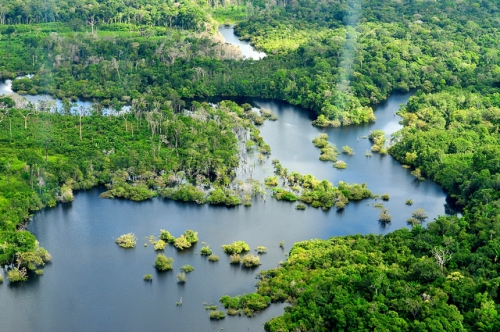
Since 2000, rainfall has decreased by up to 25% across a vast swath of the southeastern Amazon, according to a new satellite analysis.
The area of concern is 12 times the size of California. The Amazon overall takes up 25% of the global carbon cycle that vegetation is responsible for, so it’s a significant carbon sink. With further drying the Amazon could become a carbon source rather than a sink.
Causes are not clear, but it’s possible that rainfall patterns have moved further north with global warming.
In related news, the re-election of Dilma Rousseff as president is seen as a significant negative for the environment in Brazil.
2. Great Barrier Reef protection plan ‘ignores the threat of climate change’
In its formal response to the Reef 2050 long-term sustainability plan, which was drawn up by the Australian and Queensland governments, the Australian Academy of Science states the strategy is “inadequate to achieve the goal of restoring or even maintaining the diminished outstanding universal value of the reef.”
There is “no adequate recognition” in the 2050 plan of the importance of curbing greenhouse gases.
Professor Terry Hughes, director of the Australian Research Council Center of Excellence for Coral Reef Studies and an academy fellow, said the plan was focused on the sustainable development of four “mega ports” adjacent to the reef, rather than conservation of the reef itself.
The Great Barrier Reef has lost around half its coral cover in the past 30 years. The question now is whether UNESCO will list the GBR as endangered.
3. Limiting global warming to 2°C is unlikely to save most coral reefs
In this recent post I mentioned that “preserving more than 10 per cent of coral reefs worldwide would require limiting warming to below +1.5°C (atmosphere–ocean general circulation models (AOGCMs) range: 1.3–1.8°C) relative to pre-industrial levels”. Following the links, the paper by K. Frieler at al is here.
It annoys me that the dangers to reefs from temperature change and ocean acidification are almost never mentioned, even by greenies. Opposition pollies should be speaking up too! That paper has been around since 2011.
4. Carbon capture and storage research budget slashed
The government has cut almost half a billion dollars from research into carbon capture and storage – which the Intergovernmental Panel on Climate Change (IPCC) deems crucial for continued use of coal – despite the prime minister insisting coal is the “foundation of our prosperity”.
In the budget the government cut $459.3m over three years from its carbon capture and storage flagship program, leaving $191.7m to continue existing projects for the next seven years. The program had already been cut by the previous Labor government and much of the funding remained unallocated.
John Connor, the chief executive of the Climate Institute, said CCS “has to be one of the clean energy options available because all the modelling says that to avoid temperature rises of more than two degrees, we have to take carbon dioxide out of the atmosphere”.
The first full-scale CCS power plant, the Boundary Dam Carbon Capture and Storage Project in Canada, opened last month.
5. Poland rejects zero coal by 2100
Poland and a bunch of eastern Europe countries “have categorically rejected the target put forward by the world’s top climate scientists to reduce carbon emissions to zero by 2100 to avoid dangerous global warming…”
You might recall that when Poland hosted the UNFCCC Conference of Parties in 2013 it was positively promoting coal.
The EU has not yet apportioned the effort between countries in planning to meet recently announced emissions reduction targets. The fun is about to begin!
6. Roof top solar in San Francisco
New regulations in San Francisco will require new buildings to have roof top solar or gardens or both.
7. Tesla solar supercharging network
Tesla is rolling out a solar supercharging network for electric vehicles throughout the world eventually. Soon they will make a beginning in Australia.
The superchargers provide half a full charge in as little as 20 minutes, and are usually located near amenities like roadside restaurants, cafes, and shopping centers. Usually they have between 4 and 10 stalls.
The $5 billion “giagfactory” to be built in Nevada will generate more than 100% of its electricity needs with wind and solar.
The world is changing!
8. News of energy storage is a big, big deal
So says Sophie Vorrath at RenewEconomy:
The big announcements keep coming from the energy storage sector, with news this week that US behind-the-meter startup, Stem, has been tapped to provide 85MW of distributed energy storage to households in the West Los Angeles Basin.
The deal, a multi-year agreement awarded to Stem by Southern California Edison (SCE), marks America’s largest distributed energy storage project to date, and the first time energy storage has competed with traditional energy sources like natural gas at this scale.
For its part of the deal, Stem will deploy its advanced, behind-the-meter energy storage technology at customer locations in the Western LA Basin to act as dispatchable capacity to enhance the local reliability of the region.
In other words, using the combination of storage and its proprietary software platform, Stem will allow customers to monitor and manage energy use, which in turn will provide additional capacity to SCE.
9. Billboard banned
You may have heard that Brisbane Airport banned a billboard suggesting to incoming G20 delegates that climate change should be on their agenda. Apparently the billboard was “too political”.

Getup and a bunch of other NGOs are campaigning to have the decision reversed.
The billboard was based on the experience of South Australian grape grower David Bruer, a farmer from South Australia who lost $25,000 worth of grapes in one day when temperatures soared to 45°C last year.
Simpson Desert crossing 4: Day 3
We woke once again to a setting moon. Continue reading Simpson Desert crossing 4: Day 3
Saturday salon 8/11

An open thread where, at your leisure, you can discuss anything you like, well, within reason and the Comments Policy. Include here news and views, plus any notable personal experiences from the week and the weekend.
For climate topics please use the most recent Climate clippings.
The gentleman in the image is Voltaire, who for a time graced the court of Frederick II of Prussia, known as Frederick the Great. King Fred loved to talk about the universe and everything at the end of a day’s work. He also used the salons of Berlin to get feedback in the development of public policy.
Fred would only talk in French; he regarded German as barbaric. Here we’ll use English.
The thread will be a stoush-free zone. The Comments Policy says:
The aim [of this site] is to provide a venue for people to contribute and to engage in a civil and respectful manner.
Here are a few bits and pieces that came to my attention last week.
At the end of the week the star turn was Jacqui Lambie digging in over defense pay, lashing out at Abbott and taunting Clive palmer, daring him to sack her.
Glenn Lazarus has directly urged soldiers to ignore his colleague Jacqui Lambie and her call to protest at Remembrance Day ceremonies as Clive Palmer struggled to keep his disparate group of Senators together on Friday.
But a defiant Senator Lambie taunted leader Clive Palmer to prevent the party from splitting in the Senate and challenged her colleagues to help her block all Government legislation until the Defence Force is given a better pay rise.
Lazarus:
“Do not turn your back on any Remembrance Day activity or ceremony. Honour and respect those who have given the ultimate sacrifice,” he said.
“I married into a defence family and I understand firsthand the challenges defence personnel and their families deal with and the sacrifices they make for this country.
“Remembrance Day should be above politics,” he said.
It’s possible to feel sorry for Clive Palmer!
2. Whitlam remembered

David Marr says there was lingering sadness along with cheers and soaring oratory. I heard parts of it. I particularly liked John Faulkner’s speech, also his son Tony. Everyone has been raving about Noel Pearson’s speech. From what I’ve read he said some good stuff, but sounded stagy, self-consciously the orator.
Abbott and Howard were booed on entry, as is proper, Julia Gillard was welcomed effusively, Kevin Rudd in silence.
Lenore Taylor warns that right now Whitlam’s legacy in schools and universities is being dismantled.
3. Is the media biased, or not?
Let’s try a thought experiment: imagine the Rudd government had, within a few short months of being elected, fallen significantly behind Brendan Nelson’s opposition in the polls; imagine that it had produced a budget universally panned as unfair, one that it struggled to get through the Senate, that Cabinet was leaking like a sieve without any wire mesh, that treasurer Wayne Swan had made repeated gaffes and been forced to apologise and was widely regarded as a growing liability, that corruption in the NSW Labor Party had forced a Labor minister to stand aside within months of being sworn in, that Kevin Rudd had consistently negative personal ratings and at times fell behind Nelson as preferred PM, that Rudd was so unpopular, state Labor leaders preferred he kept away from them during their election campaigns, that Labor had announced it was doubling the budget deficit, and if it was reliant on a political freak show of independent and minor party senators to secure passage of its bills.
And imagine if the Rudd government had resorted to national security in an effort to take the focus off its domestic woes, and it had failed to restore its fortunes, leaving it still trailing the Coalition?
Now imagine how all that would have been reported — and not just by the Coalition cheerleaders at News Corp, but by the entire media? You wouldn’t have been able to click on a news website without seeing “debacle”, “crisis”, “fiasco” and “Whitlamesque” in every political story.
4. Stop the ABC!
So here’s a reminder of why there’s ongoing bleating in the commercial media about the ABC:
1. Insiders (ABC 216,000 + 108,000 on News 24) — 324,000
2. Weekend Sunrise (Seven) — 305,000
3. Landline (ABC) — 291,000
4. Weekend Today (Nine) — 237,000
5. Offsiders (ABC) — 138,000
6. The Bolt Report (Ten) — 131,000
7. Financial Review Sunday (Nine) — 130,000
8. The Bolt Report repeat (Ten) — 84,000Poor Bolter. It’s a truth universally noted that once a program hits a level, it usually stays at that level.
Here’s the wonderful David Rowe cartoon at the head of the post:

5. Business leaders lose confidence in Abbott Government
Only on the ABC:
The Prime Minister Tony Abbott likes to boast that Australia is open for business, but his government appears to be losing friends at the big end of town.
A survey from Institute of Company Directors has found the nation’s most powerful board rooms are not happy with the Coalition’s performance.
Their confidence in the Government has slumped to the lowest level seen since last year’s election.
company directors are saying that government decisions are hurting their businesses and hurting their customers, hurting consumer confidence as well.
6. A busy week
Last week was a busy week for me, the next one will be also. Moreover, I could be out three nights which will nearly halve the time I have for posting. We’ll see how it goes!
IPCC Synthesis Report: you’ve been told!
Damian Carrington at The Guardian:
-
Climate change is set to inflict “severe, widespread, and irreversible impacts” on people and the natural world unless carbon emissions are cut sharply and rapidly, according to the most important assessment of global warming yet published.
The stark report states that climate change has already increased the risk of severe heatwaves and other extreme weather and warns of worse to come, including food shortages and violent conflicts. But it also found that ways to avoid dangerous global warming are both available and affordable.
“Science has spoken. There is no ambiguity in the message,” said the UN secretary general, Ban Ki-moon…
(Emphasis added)The IPCC Fifth Assessment Report (AR5) is found here.
Roger Jones at The Conversation:
- acting on climate is ultimately an ethical, not an economic, consideration. Insufficient policy action is a declaration of self-interest, condemning our children, grandchildren and the planetary system that supports them, to a dystopian future. That’s what the report should say.
Ban Ki-moon:
- “Leaders must act. Time is not on our side.” He said that quick, decisive action would build a better and sustainable future, while inaction would be costly.
Tony (‘coal is good for humanity’) Abbott still refuses to address climate change at the G20 meeting as it would distract from discussion on growth. Nicholas Stern says climate change is core business if you’re concerned about growth:
- The G20 is the most effective forum for the discussion of the growth story of the future, the transition to the low-carbon economy.
Yet the local politics of a country of less than 25 million is being allowed to prevent essential strategic discussions of an issue that is of fundamental importance to the prosperity and well-being of the world’s population of 7 billion people.
As Giles Parkinson told radio National
- essentially what the IPCC is saying to Australia is, on its current policy settings, ‘wrong way, go back’.
Here’s Abbott in visionary mode:
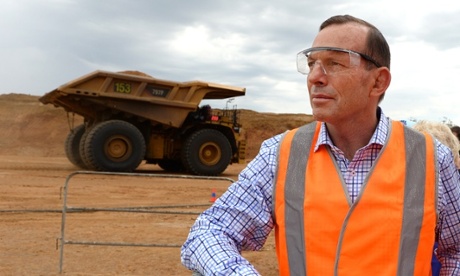
Carrington above provides a useful summary of the IPCC report. Jones identifies a change in approach:
- Instead of dealing largely in forecasts and responses, as in previous syntheses, it now frames the climate problem squarely in terms of risk management.
Jones then identifies some of the myths the report busts. Roz Pidcock at The Carbon Brief identifies what’s new and interesting about the report.
C. Forbes Tompkins and Kelly Levin at Climate Code Red list 9 significant scientific findings too recent to be included in the new IPCC report. Two of them relate to sea level rise, an increased fragility of both the Greenland and Antarctica ice sheets.
There are more links at the end of the post. I wish to comment on the appropriateness of the 2°C guardrail, the view of risk taken in relation to the 2°C and then some conclusions.
Is a 2°C temperature rise safe?
David Spratt addressed this issue in September 2013. To summarise some of what he said:
- The tipping point for Greenland Ice Sheet has been revised down to +1.6ºC (uncertainty range of +0.8 to +3.2ºC) above pre-industrial. We are likely to hit +1.6ºC within a decade or two.
- It has been shown that “preserving more than 10 per cent of coral reefs worldwide would require limiting warming to below +1.5°C (atmosphere–ocean general circulation models (AOGCMs) range: 1.3–1.8°C) relative to pre-industrial levels”.
- Large-scale thawing of permafrost may have already started, but a 1.5ºC global rise in temperature compared to pre-industrial should be enough to start a general permafrost melt.
- Current levels of CO2 at about 400 ppm place us in the Middle Pliocene epoch (3.0–3.5 Myr ago) when sea levels were 25m plus or minus 5 higher than now.
- During the Eemian 123,000 years ago sea-level rises of 3 metres occurred within 50 years due to the rapid melting of ice sheets, when the energy imbalance in the climate system was less than at present.
On sea level rise, here are the projections given in the Long Report p. 60:
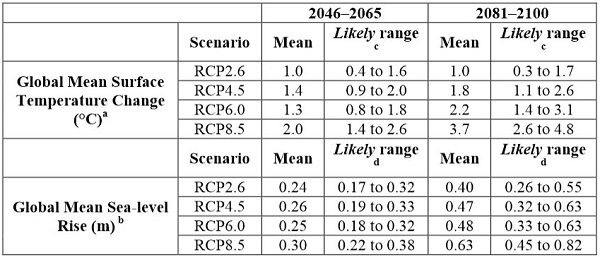
In a footnote we are told:
- Based on current understanding (from observations, physical understanding and modelling), only the collapse of marine-based sectors of the Antarctic ice sheet, if initiated, could cause global mean sea level to rise substantially above the likely range during the 21st century. There is medium confidence that this additional contribution would not exceed several tenths of a metre of sea-level rise during the 21st century.
They’ve covered themselves on Antarctica, but missed the fragility of Greenland. On page 30, they say this:
- There is low confidence in the available models’ ability to project solid ice discharge from the Antarctic ice sheet. Hence, these models likely underestimate the Antarctica ice sheet contribution, resulting in an underestimation of projected sea-level rise beyond 2100. (p30, Long report)
On sea level rise unfortunately for the next seven years we will be quoted the means given in the tables, without the qualifications, which themselves are inadequate in the late of the latest science. So the talk will be about half a metre, or up to a metre maximum.
For these and the other reasons quoted, plus a few I didn’t highlight, a 2°C guardrail looks foolhardy to say the least.
View of risk taken in relation to the 2°C
This table gives some overview of the relationship between the emissions levels, RCP scenarios, temperature change and the likelihood of staying below various temperature levels. I’ve actually taken the table from Working Group 3 and adapted it by taking out four columns (relating to quantums of CO2 and emissions reduction targets for 2050 and 2100) to highlight the broad relationships:
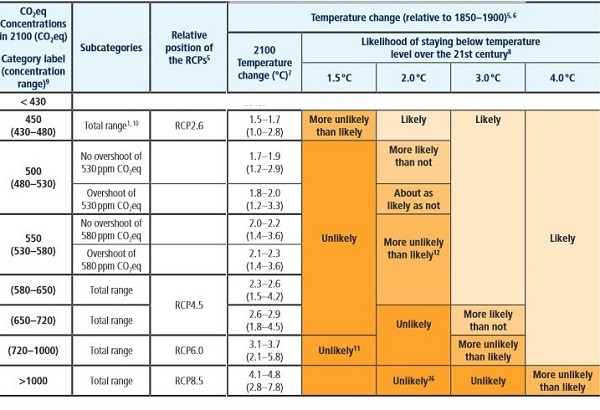
Much of the same information is given in the table on p23 (Short Report) and footnotes.
In the Short Report (p15) we are told that CO2e levels in 2011 were 430 ppm. Unfortunately the CSIRO/BOM State of the climate report says that in 2014 we are at 480 ppm of CO2 equivalent. So realistically the best on offer is the 500 zone with overshoot. This sees us with a likely as not chance of staying below 2°C. Here’s what the official language means:
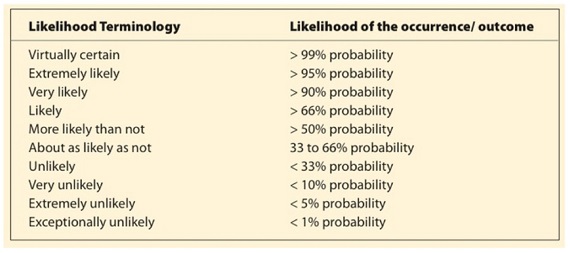
In other words a 33 to 66% chance of staying below 2°C, or if we act quickly and drastically a 66% chance. When you consider the implications even of a 1.5°C climate, this is desperately insane and simply not acceptable.
David Spratt suggests a risk-averse (pro-safety) approach, say, of less than 10% probability of whatever target we deem appropriate. I’d suggest a less than 5% probability of a 1.5°C temperature rise and then see whether that is doable. Are we game to talk about what really needs to be done for a livable, sustainable ecosystem for future generations? Or are we going to continue eating our children’s future?
Conclusions
Back in 2007 environmentalist Bill McKibbin asked James Hansen what the appropriate levels of CO2 should be. Hansen gave his answer in December 2007 at the American Geophysical Union meeting. At that very time the UNFCCC Conference of Parties was meeting in Bali. Hansen’s response was that we had overshot and that we should aim at 350 ppm by taking CO2 out of the atmosphere. To clarify, Hansen’s answer assumed that we would achieve net zero in other greenhouse gases, so he was really talking about CO2e. McKibbin went off and started up 350.org.
In a strict sense the IPCC Report is agnostic about a 2°C guardrail. It simply identifies risks, vulnerabilities and impacts at various temperature levels. However, when it comes to mitigation scenarios, it deals with what is out there in the scientific literature. Here it seems the vast bulk of the modelling contemplates scenarios where the 2°C guardrail is simply part of the furniture. Yet what has been called CCS (carbon capture and storage) and the report (see Short Report p.15 for example) re-badges as CDR (carbon dioxide removal) is also part of the furniture.
It seems to me that the scientific community is struggling to catch up with where Hansen was seven years ago. Perhaps they are concentrating on what’s doable, but at the same time they are holding out false hope. While the world’s scientists and governments have issued their bluntest warning yet, we seem to be letting go the idea of a safe climate. I heard head honcho Rajendra K Pachauri on the radio saying that we only had a budget of 275Gt of carbon (that’s about 1000GT of CO2) left that could be used. In fact, rationally, we don’t have a budget at all, we are in the red. Rationally, all the fossil fuel reserves should be left in the ground – all of them, unless offset with CCS or CDR, for which our visionary PM has just slashed the research budget.
Update:
Al Jazzeera rounds up some of the opinion warning that 2°C is foolhardy and dangerous.
- “There is no such thing as a safe rise,” said Bob Watson, who was the chair of the IPCC from 1997 to 2002. “You will see food and water insecurity, human health problems, and sea level rise even with a 2 C rise.”
And so on.
See also:
UN Climate Report Rings Alarm, Offers Guidance
World’s Scientists Warn: We Have ‘High Confidence’ In The ‘Irreversible Impacts’ Of Climate Inaction
Media round-up: The IPCC synthesis report
That last link from The Carbon Brief is quite comprehensive and includes a list of their six posts.
Related IPCC posts, in chronological order:
Crisis or catastrophe? What will the IPCC say?
A choice of catastrophes: the IPCC budget approach
Commentary on IPCC WG1: Part 1
Commentary on IPCC WG1: Part 2
Climate change impacts: IPCC Working Party 2 report
Adding to the muddle? The IPCC climate change mitigation report
Climate clippings 112
1. Will Australia be to world climate talks what Poland is to Europe?
That’s the question asked by Giles Parkinson.
On the international stage Australia plays a similar role to Poland in Europe. The two countries have much in common: their leaders share a tenuous hold on climate science, a grim determination to extract coal and use it for electricity, don’t like carbon pricing and are trying to keep a lid on renewables.
From what he says, there does seem a difference. Poland gained free carbon permits from the EU negotiations “worth more than $1 billion and promises for funds to help it “modernize” is coal-fired plants after 2020.”
Prime Minister Ewa Kopacz said after the summit that the threat of veto was simply a “tool” to get the best conditions for Poland’s economy. “Nobody got compensated like we did,” she boasted after the meeting.
In other words they were out for what they could get.
On the basis of the Abbott Government’s form in the UNFCCC Conference of Parties in Warsaw last December and actions since, we can expect Australia to be actively hostile to positive outcomes. Not just lead in the saddle bag, an active saboteur.
2. The prospect of a Republican US Senate
There is a 68% chance that the Republicans will control the US Senate after the mid-term elections. For the climate this could be a disaster.
Certainly they are unlikely to control the 60 votes they would need to avoid a Democrat filibuster, and the President has the power of veto over bills. So anti-climate legislation is not so much the worry.
However, the Republicans could block appropriate appointments to various agency positions and regulatory posts.
Secondly, any treaty coming out of the 2015 UNFCCC talks in Paris next year would need to be legislated. This would be impossible and could affect the tenor of the entire negotiations, with one large lame duck at the table.
Third, the US contributions to the IPCC and the UNFCCC could be pulled, making life for those bodies impossible.
Fourth,
a GOP majority in that house of Congress would flip several key committees into Republican hands. In particular, Sen. Jim Inhofe (R-OK) is up to take over the Environment and Public Works Committee, Sen. Ted Cruz (R-TX) would head the Subcommittee on Science and Space, Sen. Ron Johnson (R-WI) is in line to take control of the Homeland Security and Governmental Reform Committee, and Sen. Mike Enzi (R-WY) would head up the Budget Committee.
All except Enzi are avowed climate denialists.
Then there’s scary budget negotiations, and more.
3. Global groundwater crisis
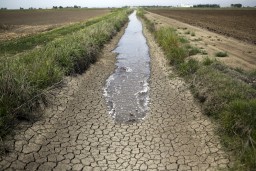
A NASA study has found that major groundwater aquifers are being depleted faster than the rate of replenishment, threatening food supplies and security.
The groundwater at some of the world’s largest aquifers — in the U.S. High Plains, California’s Central Valley, China, India, and elsewhere — is being pumped out “at far greater rates than it can be naturally replenished.”
The most worrisome fact: “nearly all of these underlie the word’s great agricultural regions and are primarily responsible for their high productivity.”
4. Geoff Cousins heads the ACF
You’ll probably recognise the gravel-voiced tones of Geoff Cousins from his campaign against the Gunns paper mill. He used 20,000 signatures from ANZ customers to pressure the bank to withdraw the project’s funds.
His business credentials include heading the country’s largest advertising company and heading Optus Vision when it slugged it out with News Ltd over rugby league broadcasting rights. He is a director of the Telstra board.
He is now President of the Australian Conservation Foundation, so expect to hear more from him. Now he’s lashed out at the Direct Action legislation and given the BCA (Business Council of Australia) a whack around the ears for supporting the legislation which he says individual companies would have rejected.
If somebody had brought a business case to the boards of one of those public companies for this program, no responsible board would have given it the time of day.
You would have asked first of all how cost efficient it was, you would have asked what was world’s best practice in all of these areas, these sorts of questions, and none of them would have been able to be answered positively in regard to this program.
The ACF are now embarking on a public education campaign about the legislation.
5. Food, Fossil Fuels and Filthy Finance
That’s the title of a report from Oxfam, summarised at Hot Topic.
On current trends, the world will be 4–6ºC hotter by the end of the century, exceeding 2ºC within the lifetimes of most people reading this report. This could put up to 400 million people in some of the poorest countries at risk of severe food and water shortages by the middle of the century.
This paper shows how, despite some steps in the right direction to tackle climate change, a ‘toxic triangle’ of political inertia, financial short-termism and vested fossil fuel interests is blocking the transition that is needed. To help break this, governments must commit to phase out fossil fuel emissions by early in the second half of this century, with rich countries leading the way.
In 2012 fossil fuel companies spent $674bn on exploration and development projects. The industry is supported by $1.9 trillion of subsidies public finance, incentives and tax breaks, including the costs of paying for its widespread damage.
Quite simply, most of the stuff should be left in the ground:

In truth, that’s generous!
Simpson Desert crossing 3: Day 2
Mt Dare, Dalhousie Springs and Purni Bore are all in the Witjira National Park. Early on Day 2 we crossed into the Simpson Desert Regional Reserve, the main practical difference to us being that we could now have a camp fire. Within the first hour we came upon the man with his front wheel off I mentioned in this post: Continue reading Simpson Desert crossing 3: Day 2






